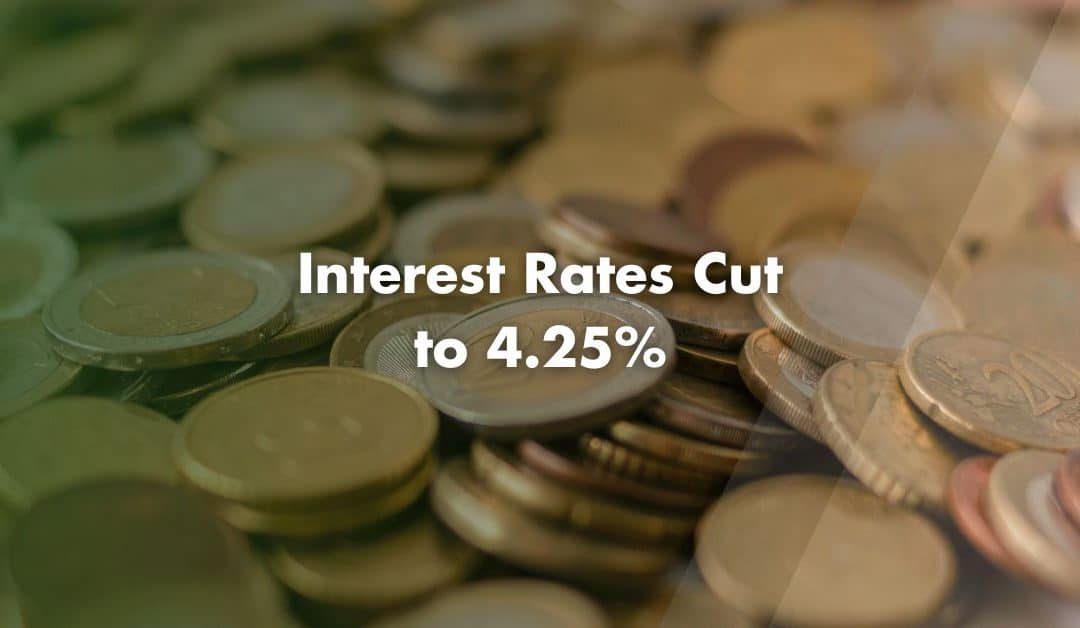The Bank of England has cut interest rates from 4.5% to 4.25%, marking the fourth cut since rates peaked at 5.25% in 2024.
Why Did the Bank of England Cut Interest Rates to 4.25%?
The decision followed a closely divided vote by the Bank’s Monetary Policy Committee (MPC). Five members supported the 0.25% percentage point cut, while two advocated for a deeper reduction to 4%, and the remaining two preferred to hold rates steady.
The MPC cited easing inflation, down to 2.6% in March, and increasing global trade tensions as the primary reasons for the change. The US recently imposed tariffs (including levies on steel, aluminium and cars) which the Bank believes will hinder global growth and prompted it to act pre-emptively.
This rate cut also recognises the progress the Bank has made in bringing inflation under control. The restrictive stance of previous monetary policy decisions has begun to take effect, and the committee sees scope to ease some of that pressure without reigniting inflation.
How Will the Rate Cut Affect Mortgage Borrowers?
For those with tracker mortgages, which follow the Bank’s base rate, payments will drop in line with the new rate. On average, homeowners can expect to save around £29 per month, equating to roughly £350 per year.
If you are on a Standard Variable Rate (SVR) mortgage, your payments could also fall, though that depends on whether your lender passes on the rate cut. Fixed-rate mortgage holders will not see immediate changes, but the outlook is positive.
Rates have been falling since early 2025, and this trend is likely to continue.
Home Buyers and Re-Mortgagers
For first-time buyers and those approaching the end of a fixed-term mortgage, the outlook is improving. Lenders are actively competing on pricing, making sub-4% fixed-rate deals increasingly accessible.
Although lenders had already priced in much of the rate cut, some may still trim rates slightly. However, borrowers should temper expectations, significant reductions are unlikely unless economic conditions change more dramatically.
What About Savers?
Lower interest rates typically mean lower returns for savers. Easy-access savings accounts are most at risk of seeing immediate reductions. Many fixed-rate accounts had already priced in this latest cuts and began offering lower rates in recent weeks.
If you hold savings in a fixed-rate bond or ISA, it is a good time to check your interest rate. Top-paying accounts currently offer between 4.55% and 4.75%, though these may fall soon. Savers should shop around to make the most of their money.
Impact on Businesses and Charities
Cheaper borrowing is good news for businesses, especially SMEs. With recent cost pressures such as higher Employers’ National Insurance Contributions and rising wage bills, the rate cut provides some much-needed relief.
Charities and not-for-profits may also benefit. Although some rely on interest income from reserves, lower rates could east cost pressures in areas like payroll and contracting. Many sector leaders see the cut as a step in the right direction.
What to Expect Next
Markets are forecasting additional cuts over the coming months. Some analysts believe the base rate could fall to 3.5% by the end of the year, depending on how inflation and economic growth evolve.
However, the Bank of England faces a delicate balancing act. Inflation may rise again, with forecasts suggesting it could reach 3.5% in the third quarter. Policymakers must ensure that cuts do not fuel a new inflationary surge while still supporting the economy through trade-related headwinds.
Contact Us
We are not just accountants; we are Chartered Accountants with one of the most reputable and premium accounting bodies. We are registered and regulated by ACCA; so you can rest assured that you are in good hands. Knowing this, don’t hesitate to get in touch with us if you require assistance: Pi Accountancy | Contact Us
This article is for general informational purposes only and does not constitute legal or financial advice. While we aim to keep our content up to date and accurate, UK tax laws and regulations are subject to change. Please speak to an accountant or tax professional for advice tailored to your individual circumstances. Pi Accountancy accepts no responsibility for any issues arising from reliance on the information provided.

